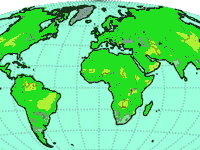1) Breathing Earth
A l'attention de tous ceux pour lesquels, même
après le film d'Al Gore, le changement climatique reste encore un
concept abstrait, un jeune étudiant américain en design,
David Bleja, a récemment mis en ligne un site qui permet de visualiser
les émissions de CO2 "en temps réel", pour chaque
pays du monde. Il faut suffit de vous connecter sur le site de son projet
Breathing Earth pour obtenir
cette mappemonde animée qui signale, pendant le temps de votre connection,
les tonnes de CO2 émises… mais aussi les naissances et
les décès (chiffres globaux et surtout par pays). Ce projet
est évidemment une simulation fondée sur des historiques
de données officielles des Nations-Unies ou d'autres instances,
mais cette nouvelle manière de voir le monde contribue néanmoins
à faire prendre conscience de notre responsabilité, à
chaque instant, face à ces enjeux … On apprend ainsi qu'en France,
1000 tonnes de CO2 sont émises chaque seconde et demi:
autant dire que le changement commence maintenant, dans le quotidien de
chacun (le site renvoie d'ailleurs l'internaute vers www.ecofoot.org, un
calculateur d'empreinte écologique individuelle proposé dans
toutes les langues par l'organisation-mère du concept, Redefining
Progress)!
Un autre
calculateur d'empreinte écologique sur notre site!
Pour en savoir plus: www.grainesdechangement.com
et www.ecofoot.org
2) First greenhouse gas
animations produced
using Envisat SCIAMACHY data
http://www.esa.int/esaEO/SEM1DUQ08ZE_planet_2.html

First ever animation of global methane distribution
Based on three years of observations from the
SCIAMACHY instrument aboard ESA's Envisat, scientists have produced the
first movies showing the global distribution of the most important greenhouse
gases – carbon dioxide and methane – that contribute to global warming.
The importance of cutting emissions from these
‘anthropogenic',
or manmade, gases has been highlighted recently with European Union leaders
endorsing binding targets to cut greenhouse gases by at least 20 percent
from 1990 levels by 2020. Further illustrating the urgency to combat global
warming, Britain became the first country last week to propose legislation
for cutting the gases.
Careful monitoring is essential to ensuring
these targets are met, and space-based instruments are new means contributing
to this. The SCIAMACHY (Scanning Imaging Absorption Spectrometer for Atmospheric
Chartography) instrument, for instance, is the first space sensor capable
of measuring the most important greenhouse gases with high sensitivity
down to the Earth's surface because it observes the spectrum of sunlight
shining through the atmosphere in ‘nadir' looking operations.
|
suite:
Dr. Michael Buchwitz and Oliver Schneising
from the Institute of Environmental Physics (IUP) at the University of
Bremen in Germany, led by Prof. Dr. John P. Burrows produced these maps
based on SCIAMACHY observations from 2003 to 2005.

Carbon dioxide mapped from 2003-2005
Although carbon dioxide is the most important
greenhouse gas, methane molecules trap heat with an efficiency that is
20 times larger than that of a molecule of carbon dioxide. Also, emissions
from methane – the second most important greenhouse gas – may significantly
rise in the future due to global warming if methane is released from currently
frozen permafrost areas.
The new methane data also confirm findings
from another study in 2005 carried out by the Institute of Environmental
Physics (IUP) at the University of Heidelberg in cooperation with the Royal
Netherlands Meteorological Institute (KMNI) of larger than expected methane
emissions over tropical rainforests, which differed from model simulations
of the same period.
"By comparing model results with satellite
observations (assuming that most differences are primarily due to shortcomings
of our current knowledge that has been included in the model), the model
is continually adjusted until it is able to reproduce the satellite observations
as closely as possible," Buchwitz said. "Based on this, we continually
improve the model and our knowledge of nature."
Data from SCIAMACHY is being provided to the
GMES Service Element for Atmosphere PROMOTE, which delivers policy-relevant
services on multiple atmospheric issues to end-users. Feedback from these
users is helping the scientists at the University of Bremen to improve
their algorithms further, which is essential for reaching the accuracy
level of 1 percent needed for SCIAMACHY to retrieve information on greenhouse
gas sources and sinks.
Buchwitz and his colleagues used SCIAMACHY
data from the same period to retrieve the columns of carbon dioxide, which
occurs naturally as well as being created through human activities, such
as the burning of fossil fuels.
As with methane, there are significant gaps
in the knowledge of carbon dioxide's sources, such as fires, volcanic activity
and the respiration of living organisms, and its natural sinks, such as
the land and ocean.
By better understanding all of the parameters
involved in the carbon cycle, scientists can better predict climate change
as well as better monitor international treaties aimed at reducing greenhouse
gas emissions, such as the Kyoto Protocol which addresses the reduction
of six greenhouse gases including methane and carbon dioxide.
With climate change being the greatest environmental
challenge facing the world today, numerous studies and results on greenhouse
gases will be presented at the 2007 Envisat Symposium in Montreux,
Switzerland, from 23 to 27 April. |